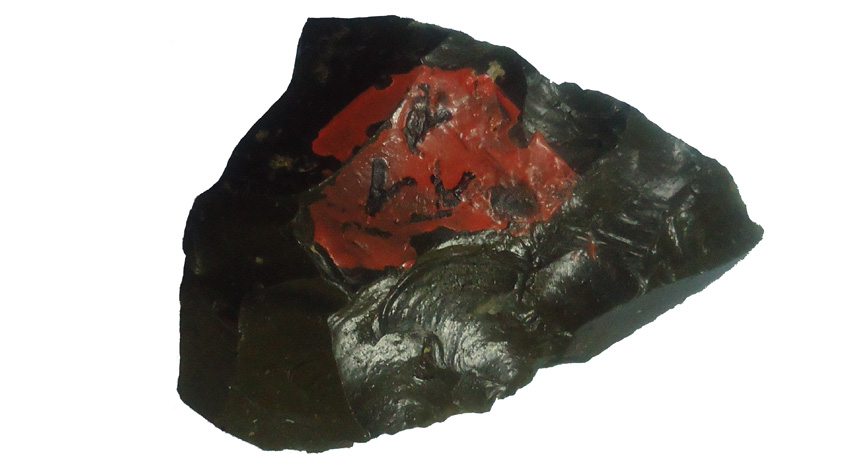Human ancestors threw spears
Ancient spear tips suggest early humanlike species were throwing sharp spears long before people did

The edge of this ancient obsidian stone point shows damage that suggests it was part of a spear thrown at animals from a short distance.
Y. SAHLE/PLOS ONE 2013
Long before guns and arrows, spears were the tool of choice for ancient hunters. Topped with sharp, pointed rocks, spears at first made it possible to kill animals by stabbing them close-up. Later, spears were sturdy enough to be thrown at animals from a distance.
Until recently, the earliest known throwing spears dated back 80,000 years. But a recent discovery in East Africa now extends that type of spear hunting to a far earlier time, one that precedes humans. It suggests that at least 279,000 years ago, an earlier, humanlike species must have been hunting big game, like hippos and antelope.
Scientists dug up spear tips from that far back in time at a site in Ethiopia called Gademotta. Back then, during the Stone Age, tools were usually made from found materials like stone, wood or bone. Any early spear-throwers at that time weren’t people but early ancestors of humans called hominids. Hominids are a family of primates that includes humans and their extinct ancestors (known only from fossils).
The ancient hominid’s spears most likely were long wooden poles topped with sharp, hand-chipped (sharpened) tips made from glassy volcanic rock, explains Yonatan Sahle. He is an archaeologist at the University of California, Berkeley, who has been studying the ancient spear tips made from this rock, known as obsidian. Given the tips’ age, his team concludes that prehuman species must have spear-hunted too. His team reported its findings Nov. 13 in the journalPLOS ONE.
The new finding challenges previously held ideas about the earliest throwers of stone-tipped spears, says John Shea. An archeologist at Stony Brook University in New York, he did not work on the new study. Previous studies had suggested ancient peoples started attaching stones to spears capable of stabbing animals close-up no earlier than 100,000 years ago.
The new find shows that more complex throwing spears were made at Gademotta long before then. They probably belonged to a species “out of which the human species evolved in eastern Africa,” Shea told Science News. Which hominid left behind the points? No one knows. Scientists have unearthed no prehuman fossils at the site.
Sahle and his coworkers studied 141 stone spear tips from Gademotta. Viewed under a microscope, 12 tips showed damage to their edges. Previous experiments have shown this type of damage comes from throwing stone-tipped spears into an animal that’s a short distance away. The scientists also found tiny marks near the base of the points, where they had been tied onto their wooden spear shafts.
The scientists estimated the age of the spear tips by where they were found. Seven were discovered beneath a layer of volcanic ash that is 279,000 years old. The rest were found buried in upper layers that were at least 105,000 years old.
Power Words
archaeology The study of human history and prehistory through the excavation of sites and the analysis of artifacts and other physical remains.
evolve To change gradually over generations, or a long period of time. In living organisms, the evolution usually involves random changes to genes that will then be passed along to an individual’s offspring. These can lead to new traits, such as altered coloration, new susceptibility to disease or protection from it, or different shaped features (such as legs, antennae, toes or internal organs).
extinct No longer in existence, as in a species or larger group of organisms.
hominid A primate belonging to the family of animals that includes humans and their fossil ancestors.
obsidian A hard, dark, glasslike volcanic rock.
primate The order of mammals that includes humans, apes, monkeys and related animals (such as tarsiers, the Daubentonia and other lemurs).
Stone Age A prehistoric period, lasting millions of years and ending thousands of years ago, when weapons and tools were made of stone or of materials such as bone, wood or horn.







